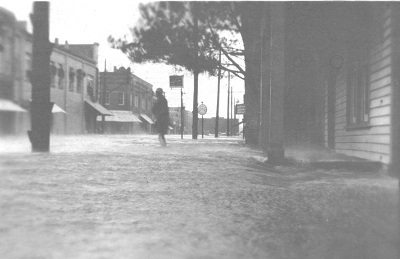This is the fourth and final part of our weeklong blog post series Century Since the Storm.
Several days after the storm passed through and the rains and winds ended, its true toll on the coast of North Carolina became apparent. In towns like Washington, which saw a record-setting 10 feet of flooding, the first major concern was the health of the citizens. Fresh water supplies were contaminated by salt and mud, and in some poorer parts of the town, residents went weeks without clean drinking water.
The fast-rising, fast-moving flood waters carried away or simply demolished many buildings, leaving thousands of people without jobs or homes. For anyone who needed to get around the city, the streets of Washington functioned more like the canals of Venice — boats took passengers from place to place along Main Street and (the appropriately named) Water Street, the two roads closest to the Pamlico River.

But in Washington and other hard-hit areas along the coast, residents rallied in support of their neighbors, donating money and helping clean up the town in the weeks following the storm. Ben Ross wrote in the Washington Daily News that “within a few weeks it was impossible to tell that Washington had ever had a storm”. However, one industry took a little longer to recover. Today’s video featurette examines the impact of the storm on agriculture, and how that industry recovered.
In the 100 years since the hurricane of 1913, plenty of other storms have hit North Carolina, and no part of our coast has been immune to them. The southern coast was battered by Hazel’s category-four winds and landfalls from Bertha and Fran in 1996, among others. The Outer Banks have seen both glancing blows from storms like the Great Hurricane of 1944 and 2005’s Ophelia, as well as direct hits from Connie in 1955 and, more recently, Isabel in 2003. And the central coastal plain — locations like Washington and New Bern, which suffered extreme damage and flooding in 1913 — have seen additional damage, especially from the flooding in 1999 after Dennis and Floyd moved through.
As these events have proven, damage from hurricanes is almost inevitable. Manmade structures and delicate coastlines are little match for nature’s most intense cyclones. However, thanks to technological advancements that help us track storms, more robust communications that have improved warning awareness and lead time, and infrastructure improvements that mean it’s now possible — and often mandatory — to evacuate vulnerable coastal communities, we are much more prepared as we enter the peak of this year’s hurricane season than we were one hundred years ago.
Sources:
- Hurricane 1913 archive from Beaufort County Community College